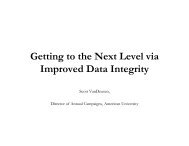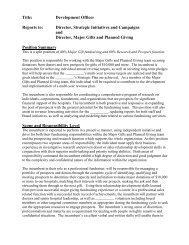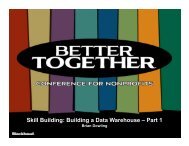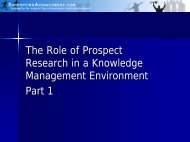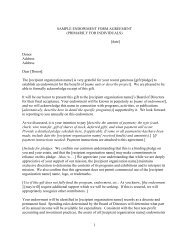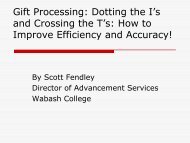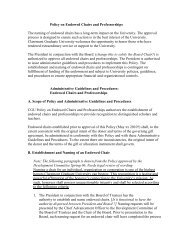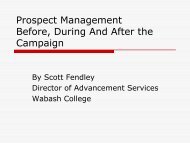WealthEngine Best Practices in Higher Education for Prospect ...
WealthEngine Best Practices in Higher Education for Prospect ...
WealthEngine Best Practices in Higher Education for Prospect ...
Create successful ePaper yourself
Turn your PDF publications into a flip-book with our unique Google optimized e-Paper software.
<strong>Best</strong> <strong>Practices</strong><br />
7<br />
Balance Precision with<br />
Timel<strong>in</strong>ess <strong>in</strong> the Validation Process<br />
When an organization acquires data through a wealth<br />
screen<strong>in</strong>g, there is almost always a need <strong>for</strong> some <strong>in</strong>itial<br />
data confirmation and validation. Among HPOs provid<strong>in</strong>g<br />
data concern<strong>in</strong>g a recent screen<strong>in</strong>g, 94% <strong>in</strong>cluded a validation<br />
strategy <strong>in</strong> their implementation plan.<br />
The extent to which the data is reviewed varies by organization,<br />
and there is not one correct way to approach the<br />
validation project. In reality, there is a cont<strong>in</strong>uum along<br />
which an organization must f<strong>in</strong>d its unique po<strong>in</strong>t of maximum<br />
return on <strong>in</strong>vestment (ROI). An organization’s placement<br />
along the cont<strong>in</strong>uum depends on the robustness of<br />
the prospect research staff, and the timel<strong>in</strong>e <strong>for</strong> push<strong>in</strong>g<br />
prospects to the front l<strong>in</strong>e. The development officers’<br />
will<strong>in</strong>gness to participate actively <strong>in</strong> the qualification and<br />
assessment of new prospects is also a factor.<br />
Because of the very nature of the wealth screen<strong>in</strong>g process<br />
and the match logic used to l<strong>in</strong>k data to specific prospects<br />
or constituents, there is <strong>in</strong>evitably some mismatched data<br />
returned <strong>for</strong> some m<strong>in</strong>or subset of constituents. Generally<br />
speak<strong>in</strong>g, <strong>in</strong> less than 10% of cases, screen<strong>in</strong>g rat<strong>in</strong>gs are<br />
higher than warranted. 1 Where screen<strong>in</strong>g rat<strong>in</strong>gs are too<br />
high, it is most frequently occurs when:<br />
A constituent matches to securities data that actually<br />
belongs to another <strong>in</strong>dividual with the same name. This<br />
happens most often among constituents with common<br />
names.<br />
Fathers/sons or mothers/daughters share the same<br />
name, particularly when they live <strong>in</strong> the same household<br />
or work at the same bus<strong>in</strong>ess.<br />
Indirect stock hold<strong>in</strong>gs <strong>in</strong>flate the hold<strong>in</strong>gs of a f<strong>in</strong>ancial<br />
services sector professional who manages funds <strong>for</strong> others.<br />
This suggests that, at a m<strong>in</strong>imum, those records represent<strong>in</strong>g<br />
constituents match<strong>in</strong>g to securities data—especially<br />
those who have common names, those <strong>for</strong> whom the<br />
organization has records <strong>for</strong> multiple generations of the<br />
same family, and those with large <strong>in</strong>direct stock hold<strong>in</strong>gs—<br />
should be reviewed prior to <strong>in</strong>vest<strong>in</strong>g <strong>in</strong> cultivation activities.<br />
A quick review of these particular areas of ambiguity<br />
will allow the data to be released with some confidence to<br />
the front-l<strong>in</strong>e fundrais<strong>in</strong>g team <strong>for</strong> action <strong>in</strong> the quickest<br />
possible time-frame. Once contacts are made, appo<strong>in</strong>tments<br />
set, and cultivation strategies are set <strong>in</strong> motion,<br />
additional data confirmation can be executed, additional<br />
research per<strong>for</strong>med, and an appropriate ask amount determ<strong>in</strong>ed.<br />
This is more easily and more accurately accomplished<br />
with the <strong>in</strong>put of both the researcher and the development<br />
officer after the DOs <strong>in</strong>dependent assessment.<br />
Approach<strong>in</strong>g the verification process <strong>in</strong> this manner has<br />
the added benefit that little if any research time is spent<br />
profil<strong>in</strong>g constituents who have no <strong>in</strong>terest <strong>in</strong> the <strong>in</strong>stitution.<br />
This will help elim<strong>in</strong>ate from the research queue<br />
prospects who are unlikely to accept a request <strong>for</strong> a visit<br />
or other cultivation <strong>in</strong>itiation. The potential downside is<br />
that development officers may occasionally spend their<br />
time or resources assess<strong>in</strong>g a prospect that does not have<br />
research-verified capacity. Given the ease with which DOs<br />
can normally make an assessment, whether <strong>in</strong>-person or<br />
via phone contact, the benefit of a faster validation process<br />
often outweighs the downside of a few “wildcards.”<br />
For some <strong>in</strong>stitutions, particularly those that have a substantial<br />
research staff and whose time frame <strong>for</strong> releas<strong>in</strong>g new<br />
prospect names <strong>in</strong>to the prospect pool is not necessarily<br />
aggressive, more validation may be warranted. Typically,<br />
the cost of research resources, <strong>in</strong>clud<strong>in</strong>g human and data<br />
resources, is substantially below that of the cost of major gift<br />
resources, <strong>in</strong>clud<strong>in</strong>g human and travel resources. There<strong>for</strong>e,<br />
when research support is available and time constra<strong>in</strong>ts are<br />
m<strong>in</strong>imal, it makes sense to confirm capacity rat<strong>in</strong>gs through<br />
research, as well as illum<strong>in</strong>ate any philanthropic <strong>in</strong>terest<br />
areas and connections to the particular organization that<br />
data can provide.<br />
This approach, while much costlier <strong>in</strong> terms of research<br />
resources, may help utilize front-l<strong>in</strong>e fundrais<strong>in</strong>g staff more<br />
efficiently. It will reduce—though not elim<strong>in</strong>ate—the<br />
number of unproductive calls development officers make.<br />
This approach does not, however, negate the need <strong>for</strong> the<br />
development officer to provide an <strong>in</strong>dependent assessment<br />
of the prospect’s <strong>in</strong>terest and aff<strong>in</strong>ity to the organization.<br />
The development officer should also be tasked with<br />
provid<strong>in</strong>g a rat<strong>in</strong>g—not to replace the capacity rat<strong>in</strong>g provided<br />
through quantifiable research, but to provide <strong>in</strong>sight<br />
<strong>in</strong>to how much the prospect may potentially donate to<br />
the particular <strong>in</strong>stitution. This rat<strong>in</strong>g would be tied to a<br />
particular gift opportunity and eventually, with luck, to a<br />
proposal and closed gift.<br />
1 In three <strong>in</strong>dependent studies compar<strong>in</strong>g <strong>WealthEng<strong>in</strong>e</strong> Capacity Rat<strong>in</strong>gs to an organization’s confirmed (verified) rat<strong>in</strong>gs, <strong>WealthEng<strong>in</strong>e</strong> Capacity<br />
rat<strong>in</strong>gs had a general accuracy of plus or m<strong>in</strong>us 1 capacity range <strong>for</strong> 70% to 80% of records. In less than 10% of cases, the <strong>WealthEng<strong>in</strong>e</strong> capacity<br />
over-estimated a prospect’s capacity. In the rema<strong>in</strong><strong>in</strong>g cases, the <strong>WealthEng<strong>in</strong>e</strong> capacity under-estimated the prospects true capacity.<br />
26 | <strong>WealthEng<strong>in</strong>e</strong>



